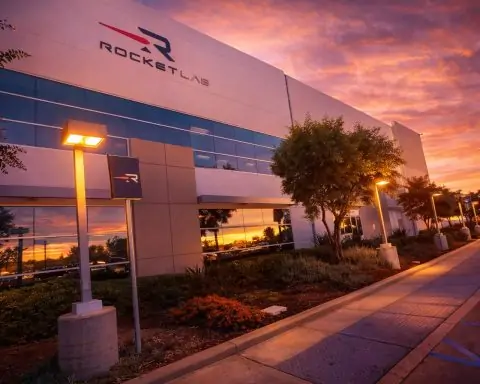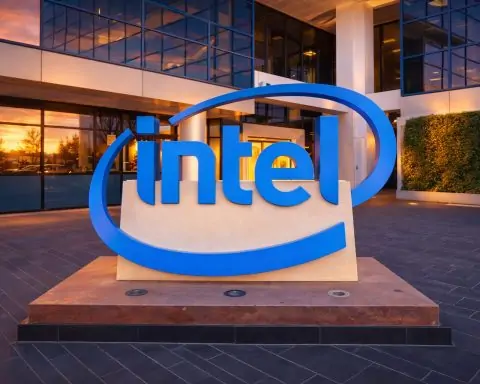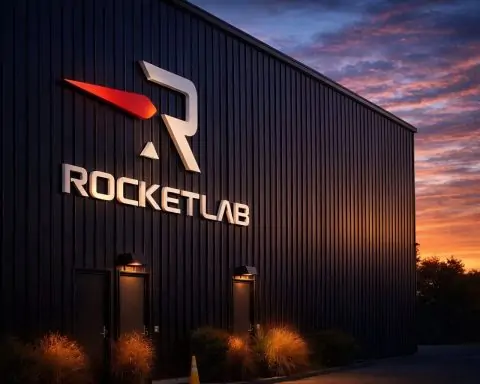- On Aug. 21, SpaceX will launch the U.S. Space Force’s X-37B spaceplane (OTV-8) on the USSF-36 mission from Kennedy Space Center, after seven prior clandestine flights since 2010 and with tests including laser communications between satellites and a quantum inertial sensor.
- SpaceX achieved its 100th launch of 2025 on Aug. 18 with a Falcon 9 mission from California carrying 24 Starlink satellites, the 72nd dedicated Starlink flight of the year, using a booster on its 9th flight that safely landed.
- Rocket Lab completed a $275 million acquisition of Geost in August 2025, expanding into satellite sensors and optics and enabling end-to-end space solutions.
- Blue Origin unveiled a concept for a Mars telecommunications orbiter using its Blue Ring bus to place a high-bandwidth relay satellite around Mars by 2028 to support NASA and commercial missions.
- The European Space Agency celebrated the Arctic Weather Satellite prototype, a 125-kg craft launched last year, whose data from a new sub-millimeter sensor prompted plans for a six-satellite Arctic constellation to improve polar weather forecasts.
- NASA moved the Orion capsule’s stage adapter for Artemis II to Kennedy Space Center, targeting a late-2026 launch to send astronauts around the Moon.
- Google introduced the Pixel 10 lineup on Aug. 20 at Made by Google in New York, with four models—Pixel 10, 10 Pro, 10 Pro XL and 10 Pro Fold—ships beginning Aug. 28 and a teased Pixel Watch 4.
- Xiaomi reported a 30.5% jump in Q2 revenue, cut its full-year smartphone shipment target to 175 million from 180 million, and delivered 81,000 EVs in Q2, while rising to No.1 in Southeast Asia and No.2 in Europe by phone shipments.
- Singapore researchers disclosed the 5G vulnerability SNI5GECT, achieving 80-90% success in lab tests within 20 meters and prompting GSMA to coordinate disclosure and vendors to patch weaknesses.
- Grann Pharmaceuticals announced that its RTT-1 mRNA LNP therapy for Rett syndrome achieved full treatment in the first patient, Eleanor, on Aug. 20 after 18 months from concept, with plans to seek FDA fast-track.
Over the past 48 hours, the global tech landscape saw major developments across hardware, software, cybersecurity, telecom, space, biotech, consumer gadgets, and transportation – all without leaning on AI. Below is a comprehensive roundup of the biggest tech news from August 20–21, 2025, with expert insights and official quotes where available.
Consumer Electronics – Smartphone Surges and New Launches
- Xiaomi’s Smartphone Boom: Chinese tech giant Xiaomi reported a 30.5% jump in Q2 revenue, driven by rising smartphone shipments (especially in Southeast Asia) that beat forecasts [1]. Xiaomi President Lu Weibing cautioned that the global phone market remains stagnant, trimming Xiaomi’s full-year shipment target to 175 million units (from 180M). “We expect the overall smartphone market to see little to no growth this year… If there is any increase, it might be around 0.1% to 0.2%,” Lu noted on an earnings call [2]. Despite headwinds, Xiaomi climbed to No.1 in Southeast Asia and No.2 in Europe by phone shipments [3]. The company also touted progress in its electric vehicle business (81,000 EVs delivered in Q2) as it aims for its first profit in that segment [4].
- Google Unveils Pixel 10 Lineup: Google officially launched its Pixel 10 smartphone series on August 20 at the Made by Google event in New York. Four models were introduced – the Pixel 10, 10 Pro, 10 Pro XL, and a foldable 10 Pro Fold – with pre-orders opening immediately and shipments set for August 28 [5]. Google also teased the new Pixel Watch 4 and updated Pixel Buds, underlining its commitment to a broad gadget ecosystem [6]. Early hands-on reviews note that the Pixel 10 family refines the Pixel 9’s design while adding upgrades like improved camera sensors and battery life [7]. Google pointedly kept the focus on hardware and user experience, with no generative AI features highlighted in this consumer rollout [8] – a strategic move to emphasize reliability and privacy. The launch timing is seen as a bid to capture early holiday shoppers before Apple’s fall iPhone event [9].
Hardware – Big Investments and Niche Devices
- SoftBank’s $2 Billion Intel Lifeline: In a dramatic boost for the semiconductor industry, Japan’s SoftBank Group is investing $2 billion in Intel for roughly a 2% stake via new shares [10]. Intel’s stock surged ~7% on Aug. 19 as investors cheered this vote of confidence [11]. SoftBank CEO Masayoshi Son called it a strategic bet: “This strategic investment reflects our belief that advanced semiconductor manufacturing… will further expand in the United States, with Intel playing a critical role,” Son said in a statement [12]. Some analysts are skeptical of the small stake’s impact. “SoftBank’s investment helps, but it is not what is going to move the dial for Intel,” cautioned Amir Anvarzadeh of Asymmetric Advisors, suggesting the deal is more about keeping favor with U.S. regulators than a cure-all for Intel’s challenges [13]. Nonetheless, the cash infusion comes as Intel fights to regain technological ground (after its first annual loss since 1986) and expand U.S. chip production [14].
- Rugged Phone & PlayStation Slim Teasers: Beyond flagship phones, niche hardware made news. U.S. firm Sonim Technologies rolled out the XP3plus 5G, an ultra-rugged flip phone built for first responders and field workers. Launched on AT&T’s network on Aug. 19, the device is FirstNet-certified and meets military-grade durability standards [15] – highlighting demand for tough, no-frills phones in the 5G era. Sonim emphasized features like a super-loud speaker, push-to-talk button, and long battery life for mission-critical use [16]. Meanwhile in gaming, Sony quietly signaled a potential PlayStation 5 “Slim” model. Regulatory filings in Japan (dated Aug. 20) point to a lighter PS5 revision in the works [17], sparking anticipation of a slimmer console launch. Sony hasn’t officially announced it yet, but industry watchers are on alert after the filing details leaked [18]. These developments – from Google’s premium Pixels to a humble flip phone and a hinted PS5 Slim – illustrate the breadth of hardware innovation, with devices tailored to very different users [19] [20].
Software & Enterprise – Cloud Moves Without AI
- Cloudera’s Multi-Cloud Play: In enterprise software news, hybrid-cloud data firm Cloudera announced it has acquired Taikun, a startup specializing in managing Kubernetes across multi-cloud and on-premises environments [21]. The goal is to give companies a “cloud-like experience anywhere” for their data and apps. “This acquisition marks a pivotal step in our mission to bring the cloud experience wherever enterprise data resides,” said Cloudera CEO Charles Sansbury, who touted the deal as removing barriers for customers deploying services across data centers and clouds [22]. Taikun’s team will form a new Cloudera development hub in Europe, and its former CEO called the timing “critical… enabling clients to deploy services seamlessly in the data center or in multi-cloud environments” [23]. The move underscores how traditional enterprise vendors are expanding tools for complex cloud setups – staying clear of any AI-specific add-ons in this case [24].
- Tech Market Jitters: Broader enterprise IT felt turbulence in financial markets. On Aug. 20, investors pulled back from tech stocks ahead of a key Fed meeting, sending the Nasdaq down about 1.5% [25]. The vaunted “Magnificent Seven” mega-cap tech companies all fell – notably Nvidia sank 3.5%, its sharpest drop in months [26]. “It seems like folks are hedging a little going into Jackson Hole, thinking [Fed Chair] Powell might be more hawkish than markets appreciate,” explained James Cox of Harris Financial Group [27]. Another analyst observed profit-taking: “Investors are taking some profits from tech stocks and rotating into other sectors. (This) spills into the broader market because of those stocks’ weight in major indices,” said Steve Sosnick, chief strategist at Interactive Brokers [28]. Despite the two-day slide, most enterprise software and cloud firms have held on to strong year-to-date gains [29], reflecting cautious optimism in the sector as 2025 progresses.
Cybersecurity – Breaches Hit Tech Firms and Telecoms
- Workday Breach via Social Engineering:Workday, a leading enterprise HR and finance software provider, revealed it was the victim of a crafty data breach that illustrates the growing menace of social engineering. Hackers impersonated IT staff at a third-party customer support vendor and tricked an employee, gaining access to Workday’s customer support tickets database [30]. The incident (disclosed Aug. 19) exposed some clients’ names, email addresses, and phone numbers – information that could be leveraged for follow-up phishing scams [31]. Critically, Workday asserts its core systems and sensitive customer data were not compromised. “All signs show that our customer Workday data remains secure,” a company spokesperson assured [32]. The attack has been linked to the ShinyHunters hacking group [33], which has a pattern of targeting software-as-a-service platforms. Workday said it has notified affected customers and strengthened authentication protocols with its partners [34]. The incident is a wake-up call that even without exploiting any AI, attackers can still exploit human trust and third-party partners to infiltrate top tech firms.
- Telecom Data Breaches (UK & Australia): Two major telecommunications providers – one in the UK and one in Australia – suffered serious data breaches that came to light on Aug. 19, raising alarms about telecom infrastructure security. In Britain, Colt Technology Services (a global telecom and data center operator) was hit by a ransomware attack claimed by a group calling itself “Warlock” [35]. The breach forced Colt to take some internal systems offline, disrupting customer portals and business operations [36]. The hackers are reportedly attempting to sell stolen Colt data on the dark web. Colt said it isolated the intrusion to an internal server separate from customer networks, and it is working “tirelessly” to restore systems, protect clients, and notify authorities [37]. Cyber experts note that as a designated critical infrastructure provider in the UK, Colt’s breach is especially concerning. “This is the kind of incident every organization dreads… Service providers are on the frontline… facing intense pressure not only to maintain continuity but also to safeguard sensitive data, making them especially attractive targets,” commented Darren Williams, CEO of cybersecurity firm BlackFog [38]. Meanwhile in Australia, the country’s #2 internet provider TPG Telecom disclosed a separate intrusion into the systems of its iiNet subsidiary [39]. Attackers using stolen employee login credentials infiltrated an order management database, exposing about 280,000 customer email addresses, 20,000 phone numbers, 10,000 street addresses, and some account passwords [40]. Fortunately, no financial information or ID documents were in that system [41]. TPG cut off the unauthorized access over the weekend and hired outside cyber forensics teams to investigate [42]. Early evidence points to compromised employee credentials – a common attack vector. The company is contacting affected users and urging password resets and multi-factor authentication [43]. Australia’s cybersecurity agency and privacy regulators have been notified [44]. The incident follows a string of high-profile Aussie breaches last year (at Optus, Medibank, etc.), keeping cybersecurity in the national spotlight.
- 5G Network Vulnerability Research: On the defensive side, researchers in Singapore exposed a troubling vulnerability in 5G mobile networks. The team from Singapore University of Technology and Design developed a proof-of-concept attack called “SNI5GECT” that can eavesdrop on and tamper with 5G communications without needing a fake cell tower [45]. Instead of the traditional “stingray” approach, the method passively sniffs 5G signal exchanges between a user’s phone and a legitimate base station, then injects malicious messages into the downlink in real time [46]. This allows an attacker to potentially crash a device, force it to downgrade to less secure 4G/3G networks, or even capture user identities, all while remaining hard to detect [47]. In lab tests on multiple 5G devices and carriers, the researchers achieved an 80–90% success rate for certain exploits within a 20-meter range [48]. They even demonstrated a multi-stage downgrade attack that stealthily pushes phones onto older networks with known vulnerabilities [49]. The GSM Association (GSMA), which oversees global mobile standards, has acknowledged the findings and initiated a coordinated disclosure process with vendors [50]. Carriers and equipment makers are now working on patching these protocol weaknesses. The takeaway: as 5G rolls out worldwide (with new networks launching as noted above), its security still has gaps, and proactive hardening is needed to prevent espionage and disruption.
Telecommunications – 5G Expansion from Turkey to Malaysia
- Turkey Fast-Tracks 5G Rollout: The Turkish government is accelerating its long-awaited 5G deployment. Adbulkadir Uraloğlu, Turkey’s Minister of Transport and Infrastructure, confirmed on Aug. 19 that the country will publish specs this month for a 5G spectrum auction to be held in October 2025 [51]. “We aim to… hold the tender in October. Our goal is to expand 5G across the entire country within a few years after the initial signal in 2026,” Uraloğlu announced [52]. Turkey’s three major mobile operators – Turkcell, Türk Telekom, and Vodafone Turkey – are all expected to bid on 11 frequency blocks in the 700 MHz and 3.5 GHz bands [53]. The minimum total price is set at about $2.13 billion for the licenses [54], which will also include renewal of existing 4G licenses (due in 2029) in exchange for a 5% revenue share to the government. This aggressive push aligns with President Erdoğan’s emphasis on tech self-reliance. After some delays (officials initially hoped for an August auction), the new October timeline underscores Ankara’s determination to catch up in the global 5G race [55]. Analysts note Turkey has studied European 5G rollouts and will likely prioritize wide coverage and local infrastructure development.
- Malaysia Launches 2nd 5G Network: A major milestone in Malaysia’s telecom sector: the country now has two competing 5G networks after originally planning for just one. On Aug. 19, carrier U Mobile activated its brand-new “ULTRA5G” service, officially becoming Malaysia’s second 5G provider [56]. Initial coverage is modest – limited to parts of Kuala Lumpur’s Berjaya Times Square and the 14-km Penang Bridge – but U Mobile aims to reach 80% population coverage by late 2026 as it rapidly builds out the network [57]. “U Mobile is proud to launch ULTRA5G… As the nation’s newest 5G network provider, U Mobile is focused on enabling digital transformation for consumers and businesses alike,” said Woon Ooi Yuen, U Mobile’s CTO, at the launch [58]. He highlighted that ULTRA5G will power everything from “ultra-reliable streaming and immersive gaming” for consumers to advanced enterprise uses like XR, smart cities and automation [59]. The debut of a second 5G network follows a policy shift by Prime Minister Anwar Ibrahim’s administration to introduce competition instead of a single state-run network. Previously, Malaysia relied on one wholesale 5G grid operated by Digital Nasional Berhad (DNB). Now, U Mobile’s entry – even using Huawei and ZTE gear – signals an independent path in 5G deployment, diverging from U.S. recommendations [60]. DNB already covers 82% of Malaysians with 5G [61], so U Mobile must play catch-up. Notably, other Malaysian carriers have recently invested an extra MYR 1 billion ($216 M) into DNB [62], even as they may eventually collaborate with or compete against U Mobile. The emergence of two 5G networks marks a new era of both collaboration and competition in Malaysia’s telecom landscape [63].
Space Tech – Military Spaceplane & Record Launch Cadence
- Space Force’s Secret Spaceplane Launch: The U.S. Space Force is poised for a headline-grabbing orbital test flight that blurs the line between sci-fi and reality. On Aug. 21, SpaceX will launch the X-37B – an unmanned, reusable spaceplane often dubbed the Pentagon’s “not-so-secret secret” orbiter – on its latest mission (OTV-8) from Kennedy Space Center [64]. Final launch preparations were underway through Aug. 19 with the X-37B already tucked inside a Falcon 9 rocket fairing [65]. This winged mini-shuttle has flown seven clandestine missions since 2010; for its eighth voyage it will test cutting-edge technologies like laser communications between satellites and a quantum inertial sensor for navigation, among other experiments [66]. “OTV-8 exemplifies the X-37B’s status as the U.S. Space Force’s premier test platform for the critical space technologies of tomorrow,” said William Blauser, acting director of the Air Force’s Rapid Capabilities Office, which oversees the X-37B program [67]. The Space Force remains tight-lipped about the spaceplane’s specific activities and even its mission duration – past X-37B flights have stayed in orbit for up to 908 days straight [68]. However, officials are touting the broader significance. “This mission is about more than innovation. It’s about making our Joint Force more connected, more resilient, and ready to operate in the face of any challenge,” wrote Gen. Chance Saltzman, the Space Force’s Chief of Operations, framing OTV-8 as a step toward a tougher, “connected” military space infrastructure [69]. The launch (designated USSF-36) also marks a first: it’s SpaceX’s inaugural launch of the X-37B, as previous missions used ULA’s Atlas V rockets [70]. With geopolitical tensions extending to orbit, the world will be watching what new tricks this secretive spaceplane performs.
- SpaceX’s 100th Launch of the Year: Elon Musk’s SpaceX continues to rewrite the playbook for rocket launch cadence. On Aug. 18, SpaceX notched its 100th launch of 2025, flying a Falcon 9 from California that carried 24 Starlink internet satellites [71]. This pace far outstrips last year’s – “Falcon launch #100 of 2025. For reference… we hit 100 on Oct. 20 in 2024,” SpaceX vice president Kiko Dontchev noted, highlighting the roughly two-month leap ahead [72]. The mission was the 72nd dedicated Starlink launch just this year [73], underscoring how SpaceX’s deployment of its massive internet satellite constellation is now dominating global launch traffic. The veteran Falcon 9 booster used for the mission completed its 9th flight and safely landed again, exemplifying SpaceX’s reusability model [74]. Industry analysts say that if SpaceX sustains this tempo, it could approach 130–140 launches by year-end – an unprecedented rate for a commercial launch provider, rivaling Cold War-era superpower launch totals [75]. One space industry report noted this achievement “underscores SpaceX’s aggressive push for global broadband coverage,” as the company races to build out Starlink’s network [76]. Competitors like ULA and Europe’s Arianespace remain far behind (each only in the single-digit launches for 2025 so far), leaving them scrambling to increase their own launch rates [77]. SpaceX’s breakneck launch schedule, driven largely by Starlink, is reshaping the satellite industry – forcing others to adapt or fall behind.
- Commercial Space Roundup: The past two days also brought notable moves in the space industry beyond launch counts. Rocket Lab, the U.S.-New Zealand small launch company, announced it has completed the $275 million acquisition of Geost, an Arizona-based maker of satellite sensors and optics [78]. The deal (first agreed in May) expands Rocket Lab beyond launch services into building satellite components, especially electro-optical and infrared sensors key for missile-warning and space-domain awareness. It’s part of Rocket Lab’s strategy to offer end-to-end space solutions, and follows its recent expansion into satellite manufacturing. Meanwhile, Blue Origin – Jeff Bezos’s space venture – unveiled a proposal for a Mars telecommunications orbiter to NASA [79]. The concept, based on Blue Origin’s new “Blue Ring” satellite bus, would place a high-bandwidth relay satellite around Mars by 2028 to support future NASA and commercial missions on the Red Planet [80]. This signals private players angling to fill infrastructure gaps for deep-space exploration. Over in Europe, the European Space Agency (ESA) celebrated the success of its prototype Arctic Weather Satellite, a small 125-kg spacecraft launched last year. After 12 months in orbit, the satellite’s novel instruments have “far exceeded our expectations,” delivering data to improve European weather forecasts [81]. The strong performance (using a new sub-millimeter sensor to profile atmospheric humidity and ice clouds) has inspired plans for a constellation of six Arctic satellites to boost weather forecasting in polar regions [82]. And back in the U.S., NASA moved the final major piece of its Artemis II moon mission hardware – the Orion capsule’s stage adapter – to Kennedy Space Center [83]. With Artemis II components nearly assembled, NASA is eyeing a late-2026 launch to send astronauts around the Moon, even as work begins on the Artemis III lunar lander’s core stage [84]. In all, space news these days spanned from Earth’s poles to Mars, and from factory floors to launch pads – a reminder of global momentum in space tech. Crucially, none of these achievements leaned on any AI breakthroughs to reach their lofty goals [85].
Biotech – Corporate Shakeups, Drug Results & Medical Breakthroughs
- CSL Restructures R&D Operations: In the biotech and pharma arena, Australian pharmaceutical giant CSL announced a sweeping restructuring plan to cut costs and refocus its research efforts. The company will lay off up to 15% of its workforce in a bid to save approximately $500–550 million per year on R&D [86]. CSL also intends to spin off its vaccines division as a separate entity [87]. The cost-cutting plan, revealed in CSL’s earnings report, will incur a one-time cost around $700–770 million but is aimed at creating a leaner organization concentrated on priority programs [88]. Executives had foreshadowed the move in July, calling for a “smaller global internal workforce” to boost efficiency [89]. The layoffs underscore challenges across big biotech firms to balance expansive R&D pipelines with profitability pressures.
- Medtronic Faces Activist Investor: Medtech leader Medtronic reached an agreement with activist investor Elliott Investment Management, which had recently taken a significant stake in the company [90]. Under the deal, Medtronic will expand its board with two new directors (with healthcare M&A expertise) and form new committees to pursue cost cuts and “tuck-in” acquisitions [91]. Elliott has been pushing for improved margins and strategic changes – including a planned $2.8 billion spin-off of Medtronic’s diabetes device unit – to unlock more value. “Our decision to become one of Medtronic’s largest investors was driven by strong conviction… [the] company is entering a new chapter of exceptional value creation,” said Marc Steinberg, Elliott’s portfolio manager leading the campaign [92]. His optimistic quote signals that the activist believes streamlined operations and targeted deals will accelerate Medtronic’s growth. The truce with Elliott suggests Medtronic’s management is taking shareholder pressure seriously amid a broader trend of activist investors eyeing healthcare and biotech firms.
- Weight-Loss Drug Trial Disappoints: On the clinical front, a closely watched obesity drug trial yielded mixed results. Viking Therapeutics announced that its experimental oral weight-loss pill (VK2735) helped patients lose 12.2% of their body weight on average in a 13-week mid-stage trial – a respectable reduction but below Wall Street’s hoped-for ~15% [93]. The data, released Aug. 19, sent Viking’s stock plunging 41% as investors reacted to the shortfall [94]. In the 280-patient Phase II study, those on the highest dose lost 12.2% weight vs. 10.9% for placebo, making the drug’s placebo-adjusted benefit quite small [95]. Moreover, about 20% of patients on VK2735 dropped out due to side effects (mainly GI issues like nausea and vomiting), compared to 13% dropout in the placebo group [96]. Viking’s CEO said the dosing schedule may be adjusted (titrating more slowly) in future trials to improve tolerability [97]. Analysts noted that while an oral pill could tap huge demand from patients averse to injectables, rivals’ injectable drugs still show superior efficacy. “(VK2735’s) profile did not measure up to earlier trials, but side effects might be manageable with dose adjustments,” observed J.P. Morgan analyst Hardik Parikh, suggesting the drug might perform better with a modified regimen given the high placebo-group dropout rate [98]. The setback for Viking highlights the intense competition in weight-loss therapies – as pharma giants like Novo Nordisk and Eli Lilly push ahead with their own obesity pills showing ~12–15% weight loss over longer periods [99].
- mRNA Therapy Breakthrough for Rare Disease: There was also rare good news on the medical innovation front. Grann Pharmaceuticals, a small biotech startup in San Marcos, California, announced a major milestone in treating Rett Syndrome, a devastating genetic neurodevelopmental disorder with no cure. On Aug. 20, Grann revealed that the first patient – a young girl named Eleanor – has successfully completed the full regimen of the company’s experimental therapy, RTT-1 “Eleanor” [100]. RTT-1 is an mRNA lipid nanoparticle (LNP) therapy designed to replace the critical protein that is missing in patients with Rett Syndrome (caused by mutations in the MECP2 gene). Grann was able to go from proof-of-concept to treating this first patient in just 18 months [101]. The child tolerated the therapy well, a crucial early sign of safety [102]. Grann now plans to seek long-term FDA approval to continue Eleanor’s treatment and to advance RTT-1 into further trials [103]. “This is a pivotal moment for our company, for the Rett community, and for the field of medical genetics,” said Thomas Lyle Temple, CEO of Grann Pharmaceuticals. “We are committed to accelerating development so we can deliver innovative mRNA LNP therapies to Eleanor and children like her… For the first time, families affected by Rett Syndrome can have new hope where none previously existed.” [104]. The breakthrough, while early, offers a glimmer of hope for a disease that robs children of motor and communication skills. Grann is now seeking partners and preparing discussions with the FDA to fast-track this therapy’s development [105]. This story highlights how biotech innovation – even without any buzzworthy AI component – continues to push boundaries in 2025, leveraging technologies like mRNA delivery to tackle rare diseases.
Sources: The information in this roundup is drawn from reputable news agencies and industry reports, including Reuters, Reuters [106] [107], Los Angeles Times [108] [109], Cybersecurity Dive [110] [111], Industrial Cyber [112], Telecoms.com [113], AndroidHeadlines [114], TS2 Technology News [115] [116], and official press releases [117], among other sources. Each major item above includes a citation linking to the original source for further details.
References
1. ts2.tech, 2. ts2.tech, 3. ts2.tech, 4. ts2.tech, 5. ts2.tech, 6. ts2.tech, 7. ts2.tech, 8. ts2.tech, 9. ts2.tech, 10. ts2.tech, 11. ts2.tech, 12. ts2.tech, 13. ts2.tech, 14. ts2.tech, 15. ts2.tech, 16. ts2.tech, 17. ts2.tech, 18. ts2.tech, 19. ts2.tech, 20. ts2.tech, 21. ts2.tech, 22. ts2.tech, 23. ts2.tech, 24. ts2.tech, 25. ts2.tech, 26. ts2.tech, 27. ts2.tech, 28. ts2.tech, 29. ts2.tech, 30. ts2.tech, 31. ts2.tech, 32. ts2.tech, 33. ts2.tech, 34. ts2.tech, 35. ts2.tech, 36. ts2.tech, 37. ts2.tech, 38. ts2.tech, 39. ts2.tech, 40. ts2.tech, 41. ts2.tech, 42. ts2.tech, 43. ts2.tech, 44. ts2.tech, 45. ts2.tech, 46. ts2.tech, 47. ts2.tech, 48. ts2.tech, 49. ts2.tech, 50. ts2.tech, 51. ts2.tech, 52. ts2.tech, 53. ts2.tech, 54. ts2.tech, 55. ts2.tech, 56. ts2.tech, 57. ts2.tech, 58. ts2.tech, 59. ts2.tech, 60. ts2.tech, 61. ts2.tech, 62. ts2.tech, 63. ts2.tech, 64. ts2.tech, 65. ts2.tech, 66. ts2.tech, 67. ts2.tech, 68. ts2.tech, 69. ts2.tech, 70. ts2.tech, 71. ts2.tech, 72. ts2.tech, 73. ts2.tech, 74. ts2.tech, 75. ts2.tech, 76. ts2.tech, 77. ts2.tech, 78. ts2.tech, 79. ts2.tech, 80. ts2.tech, 81. ts2.tech, 82. ts2.tech, 83. ts2.tech, 84. ts2.tech, 85. ts2.tech, 86. ts2.tech, 87. ts2.tech, 88. ts2.tech, 89. ts2.tech, 90. ts2.tech, 91. ts2.tech, 92. ts2.tech, 93. www.reuters.com, 94. www.reuters.com, 95. www.reuters.com, 96. www.reuters.com, 97. www.reuters.com, 98. www.reuters.com, 99. www.reuters.com, 100. www.biospace.com, 101. www.biospace.com, 102. www.biospace.com, 103. www.biospace.com, 104. www.biospace.com, 105. www.biospace.com, 106. www.reuters.com, 107. www.reuters.com, 108. ts2.tech, 109. ts2.tech, 110. ts2.tech, 111. ts2.tech, 112. ts2.tech, 113. ts2.tech, 114. ts2.tech, 115. ts2.tech, 116. ts2.tech, 117. www.biospace.com









